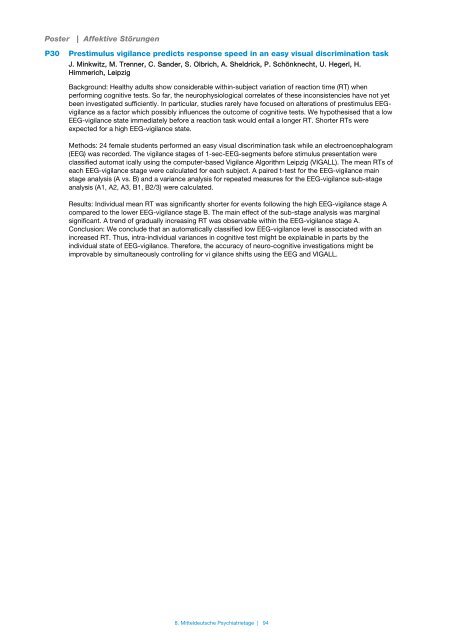Stand der Ursachen - Mitteldeutsche Psychiatrietage 2011
Stand der Ursachen - Mitteldeutsche Psychiatrietage 2011
Stand der Ursachen - Mitteldeutsche Psychiatrietage 2011
Erfolgreiche ePaper selbst erstellen
Machen Sie aus Ihren PDF Publikationen ein blätterbares Flipbook mit unserer einzigartigen Google optimierten e-Paper Software.
Poster | Affektive Störungen<br />
P30<br />
Prestimulus vigilance predicts response speed in an easy visual discrimination task<br />
J. Minkwitz, M. Trenner, C. San<strong>der</strong>, S. Olbrich, A. Sheldrick, P. Schönknecht, U. Hegerl, H.<br />
Himmerich, Leipzig<br />
Background: Healthy adults show consi<strong>der</strong>able within-subject variation of reaction time (RT) when<br />
performing cognitive tests. So far, the neurophysiological correlates of these inconsistencies have not yet<br />
been investigated sufficiently. In particular, studies rarely have focused on alterations of prestimulus EEGvigilance<br />
as a factor which possibly influences the outcome of cognitive tests. We hypothesised that a low<br />
EEG-vigilance state immediately before a reaction task would entail a longer RT. Shorter RTs were<br />
expected for a high EEG-vigilance state.<br />
Methods: 24 female students performed an easy visual discrimination task while an electroencephalogram<br />
(EEG) was recorded. The vigilance stages of 1-sec-EEG-segments before stimulus presentation were<br />
classified automat ically using the computer-based Vigilance Algorithm Leipzig (VIGALL). The mean RTs of<br />
each EEG-vigilance stage were calculated for each subject. A paired t-test for the EEG-vigilance main<br />
stage analysis (A vs. B) and a variance analysis for repeated measures for the EEG-vigilance sub-stage<br />
analysis (A1, A2, A3, B1, B2/3) were calculated.<br />
Results: Individual mean RT was significantly shorter for events following the high EEG-vigilance stage A<br />
compared to the lower EEG-vigilance stage B. The main effect of the sub-stage analysis was marginal<br />
significant. A trend of gradually increasing RT was observable within the EEG-vigilance stage A.<br />
Conclusion: We conclude that an automatically classified low EEG-vigilance level is associated with an<br />
increased RT. Thus, intra-individual variances in cognitive test might be explainable in parts by the<br />
individual state of EEG-vigilance. Therefore, the accuracy of neuro-cognitive investigations might be<br />
improvable by simultaneously controlling for vi gilance shifts using the EEG and VIGALL.<br />
8. <strong>Mitteldeutsche</strong> <strong>Psychiatrietage</strong> | 94


